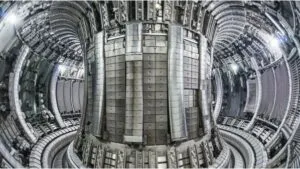The world’s most ambitious fusion energy project has reached a critical milestone as Westinghouse Electric Company takes charge of assembling the core of ITER’s fusion reactor. This massive international collaboration, based in Cadarache, southern France, aims to harness the power of nuclear fusion—the same process that powers our sun—to create clean, virtually limitless energy for humanity’s future.
In August 2025, ITER’s fusion project entered its most technically challenging phase yet : the final assembly of the reactor’s core. American nuclear giant Westinghouse secured a €168 million contract to lead this critical operation, which involves the precise installation and welding of nine massive steel sectors to form the tokamak’s vacuum vessel—the heart of the fusion reactor.

The tokamak’s vacuum vessel forms a donut-shaped chamber where fusion will eventually occur. Each 400-ton sector must be positioned and welded with millimeter precision to create a perfectly circular, hermetically sealed chamber. Inside this vessel, hydrogen plasma will be heated to over 150 million degrees Celsius—temperatures far exceeding those found at the center of our sun—to trigger nuclear fusion.
Westinghouse brings over a decade of ITER experience to this task. The company has worked in partnership with Italian firms Ansaldo Nucleare and Walter Tosto as part of the AMW consortium, which has already manufactured five of the nine vacuum vessel sectors. The expertise required for this assembly resembles handling forces of immense magnitude, where precision engineering must contain enormous energy safely.
Bernard Bigot, former ITER Director-General, once described this challenge as “assembling a three-dimensional puzzle on an industrial scale.” The vacuum vessel must withstand extreme thermal stresses, magnetic forces, and maintain perfect internal conditions for plasma containment—making it one of the most sophisticated engineering projects ever attempted.
Global collaboration of unprecedented scale
ITER represents an extraordinary example of international scientific cooperation, uniting 35 nations in pursuit of fusion energy. The project partners include the European Union, United States, China, Russia, Japan, India, and South Korea—together representing over half the world’s population and 85% of global GDP.
What makes ITER particularly remarkable is its collaborative structure. Each participating nation contributes specific components manufactured to exacting specifications before being shipped to France for assembly. This approach resembles a global supply chain for scientific advancement, with components traveling from facilities across four continents before reaching their final destination.
The scale of this international partnership exceeds even other massive scientific endeavors, creating a template for how humanity might tackle other global challenges. Much like scientists studying Earth’s transformative geological processes, ITER’s teams are witnessing the birth of something entirely new through collaborative effort.
Key ITER contributions include :
- Europe : Construction site, buildings, and 45.6% of components
- United States : Central solenoid magnet system and cooling water systems
- China : Correction coils and power supply components
- Japan : Toroidal field coils and central solenoid conductor
- Russia : Poloidal field coils and specialized diagnostic systems
Technical ambitions and timeline challenges
ITER’s primary technical goal is to demonstrate fusion power at commercial scale. The reactor aims to produce 500 megawatts of fusion power from 50 megawatts of input power—a tenfold return that would prove fusion’s viability as an energy source. This achievement would represent a breakthrough comparable to observing celestial phenomena through revolutionary telescopes, offering humanity a glimpse of its potential energy future.
However, the project has faced significant timeline adjustments since breaking ground in 2010. Initially targeting first plasma operations by 2018, the schedule has been revised multiple times due to technical complexities, supply chain challenges, and the sheer difficulty of coordinating contributions from dozens of countries. Current projections aim for meaningful deuterium-tritium fusion experiments by 2035.
This timeline extension reflects fusion energy’s persistent challenge : creating and maintaining the precise conditions for sustained nuclear fusion. The famous industry saying that fusion is “always 30 years away” highlights the technical hurdles that have consistently pushed commercialization timelines further into the future.
Leave a Reply